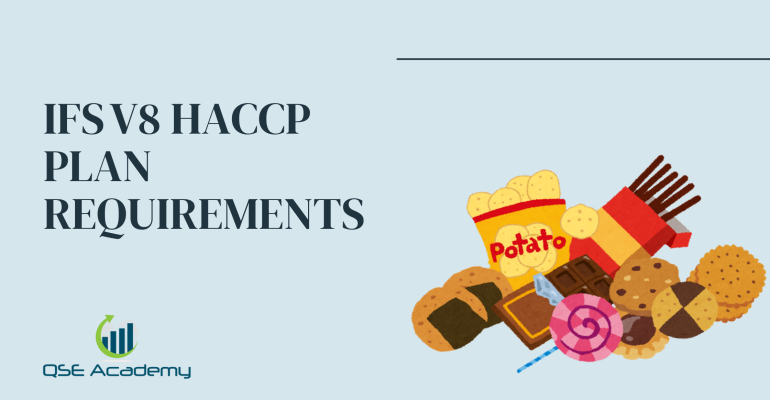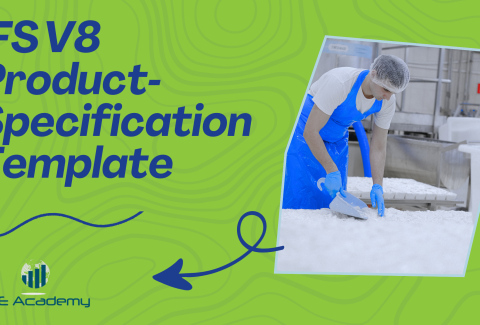IFS V8 HACCP Plan Requirements
Last Updated on November 18, 2025 by Melissa Lazaro
What IFS V8 Expects From Your HACCP Plan
When I sit down with food manufacturers preparing for IFS V8, one thing becomes clear quickly—everyone knows they need a HACCP plan, but not everyone feels confident that theirs meets IFS expectations.
Some teams have HACCP documents they created years ago and simply “update the date” before an audit. Others have overly complex plans created by consultants that no one on the team can explain. And then there are the companies that have the right intention, but their documentation doesn’t reflect what’s actually happening on the production floor.
IFS V8 raises the bar—not by reinventing HACCP, but by requiring clear evidence, competence, and alignment between what’s written and what’s practiced.
By the end of this guide, you’ll have a clear understanding of what auditors expect, how to structure your HACCP plan under IFS V8, and where companies commonly stumble.
Overview of HACCP Under IFS V8 (Codex-Based, Evidence-Driven Approach)
IFS V8 remains aligned with Codex Alimentarius principles, so the foundation hasn’t changed. What has changed is the expectation around:
- Documentation clarity
- Validation and verification evidence
- Alignment with operational controls
- Competence of the HACCP team
- Risk-based thinking beyond CCPs
A misconception I hear often is:
“HACCP is just about identifying CCPs.”
But HACCP under IFS is broader—it’s about showing your entire food-safety system is hazard-driven, validated, and consistently applied.
Prerequisite Programs (PRPs): The Foundation of HACCP in IFS V8
Before hazard analysis even begins, PRPs must be strong and functioning. These are your basic hygiene and control programs—things like sanitation, allergen control, pest management, calibration, traceability, and training.
IFS doesn’t ask for PRPs because they’re routine—it asks because without them, HACCP collapses.
Here’s a real example:
A manufacturer used two dough mixers—one for allergen-free recipes and one for recipes containing milk. The allergen control wasn’t managed as a CCP—it was a PRP based on validated scheduling, cleaning, and documented verification.
Auditors were satisfied—not because there was a CCP, but because controls were intentional, documented, and monitored.
Pro Tip:
Document how each PRP supports hazard control—it shows auditors the link between everyday operations and food safety.
Hazard Analysis Methodology (Where Most HACCP Plans Fail)
IFS expects a structured, justified, and traceable hazard analysis. That means:
- Mapping the entire process
- Identifying all potential hazards (biological, chemical—including allergens and radiological—and physical risks)
- Assessing likelihood and severity
- Assigning appropriate control measures
A simple scoring matrix often works best:
| Rating | Likelihood | Severity |
|---|---|---|
| 1 | Rare | Minor |
| 2 | Possible | Moderate |
| 3 | Likely | Severe |
Common mistake:
Using generic values with no explanation. If you assign “Severity = 3,” auditors will ask:
“How did you determine that?”
You should be able to answer confidently.
Identification & Management of CCPs (If Everything Is a CCP — Nothing Is)
Not every hazard becomes a CCP. That’s where the decision tree comes in — but only if it’s applied logically.
Typical CCP examples include:
- Pasteurization or thermal kill steps
- Metal detection or X-ray
- pH or water activity control (depending on product)
For each CCP, IFS V8 expects:
- Clear measurable critical limits
- Defined responsible personnel
- Monitoring method and frequency
- Corrective actions if limits are breached
- Records that are complete, legible, and timely
One thing I’ve noticed during audits:
When a CCP record has missing signatures or unclear entries, it signals weak control—not weak handwriting.
Validation, Verification & Review (IFS Wants Evidence, Not Promises)
This is the part many sites overlook.
- Validation proves the control method works (scientific research, lab testing, challenge studies, regulatory references).
- Verification shows it continues to work (CCP checks, audits, reviews, calibration, trend analysis).
- Review confirms the system is still relevant—at least annually or after significant changes.
Common pitfall:
Using validation from equipment manuals alone. They can support your validation—but they cannot replace it.
Documentation & Record Keeping (Make It Clear, Make It Traceable)
IFS auditors want to see:
- A complete HACCP study
- Flow diagrams
- Hazard analysis worksheets
- CCP monitoring records
- Verification and validation evidence
- Corrective action logs
- Version control
What matters most is consistency. If something is written—but the process on the floor doesn’t match—auditors will find it.
HACCP Team Competence & Training (More Than Just Names on a List)
IFS expects a HACCP team that:
- Understands the methodology
- Represents different operational areas (not just QA)
- Has documented training and competency
- Meets regularly and formally records decisions
Cross-functional teams perform best.
When production leads and operators contribute, the plan reflects reality—not theory.
FAQs
Can we reuse our HACCP plan from a previous certification standard?
Yes—but only if you update it to reflect IFS expectations, operational reality, and current validation evidence.
How often should the HACCP plan be reviewed?
At minimum annually, and any time a process, product, supplier, or regulation changes—or after a food-safety incident.
Do we need software to manage HACCP under IFS V8?
Not mandatory. Well-structured spreadsheets or controlled documents are acceptable—if traceability and control are clear.
Conclusion: A Strong HACCP Plan Makes Certification Predictable
A compliant HACCP plan isn’t just paperwork—it’s the blueprint for how your site protects food safety every day.
Once your plan is validated, monitored, and understood by your team, certification becomes far less stressful—and decision-making becomes faster and more confident.
If you’re ready, I can help you turn this structure into:
- A complete editable HACCP template
- A training version for your HACCP team
- Or a site-specific plan aligned to your products and risks
Melissa Lavaro is a seasoned ISO consultant and an enthusiastic advocate for quality management standards. With a rich experience in conducting audits and providing consultancy services, Melissa specializes in helping organizations implement and adapt to ISO standards. Her passion for quality management is evident in her hands-on approach and deep understanding of the regulatory frameworks. Melissa’s expertise and energetic commitment make her a sought-after consultant, dedicated to elevating organizational compliance and performance through practical, insightful guidance.







